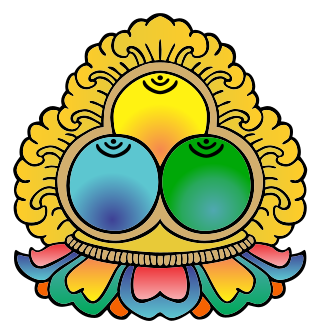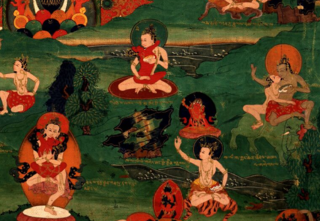Related Research Articles

Ole Nydahl, also known as Lama Ole, is a lama providing Mahamudra teachings in the Karma Kagyu school of Tibetan Buddhism. Since the early 1970s, Nydahl has toured the world giving lectures and meditation courses. With his wife, Hannah Nydahl (1946-2007), he founded Diamond Way Buddhism, a worldwide Karma Kagyu Buddhist organization with over 600 centers for lay practitioners.

Amrit Desai is a pioneer of yoga in the West, and one of the few remaining living yoga gurus who originally brought over the authentic teachings of yoga in the early 1960s. He is the creator of two brands of yoga, Kripalu Yoga and I AM Yoga, and is the founder of five yoga and health centers in the US. His yoga training programs have reached more than 40 countries worldwide and over 8,000 teachers have been certified.

Diamond Way Buddhism is a lay organization within the Karma Kagyu school of Tibetan Buddhism. The first Diamond Way Buddhist center was founded in 1972 by Hannah Nydahl and Ole Nydahl in Copenhagen under the guidance of Rangjung Rigpe Dorje, 16th Karmapa. Today there are approximately 650 centers worldwide, directed by Ole Nydahl under the guidance of Trinley Thaye Dorje, one of two claimants to the title of the 17th Karmapa. Buddhist teachers such as Sherab Gyaltsen Rinpoche, Lama Jigme Rinpoche and Nedo Kuchung Rinpoche visit Diamond Way Buddhism centers and large meditation courses.
Tara Brach is an American psychologist, author, and proponent of Buddhist meditation. She is a guiding teacher and founder of the Insight Meditation Community of Washington, D.C. (IMCW). Brach also teaches about Buddhist meditation at centers for meditation and yoga in the United States and Europe, including Spirit Rock Meditation Center in Woodacre, California; the Kripalu Center; and the Omega Institute for Holistic Studies.

Dhyāna in Hinduism means contemplation and meditation. Dhyana is taken up in Yoga practices, and is a means to samadhi and self-knowledge.

In Tibetan Buddhism, the Three Jewels and Three Roots are supports in which a Buddhist takes refuge by means of a prayer or recitation at the beginning of the day or of a practice session. The Three Jewels are the first and the Three Roots are the second set of three Tibetan Buddhist refuge formulations, the Outer, Inner and Secret forms of the Three Jewels. The 'Outer' form is the 'Triple Gem', the 'Inner' is the Three Roots and the 'Secret' form is the 'Three Bodies' or trikāya of a Buddha.

Dream yoga or milam —the Yoga of the Dream State—is a suite of advanced tantric sadhana of the entwined Mantrayana lineages of Dzogchen. Dream yoga consists of tantric processes and techniques within the trance Bardos of Dream and Sleep Six Dharmas of Naropa. In the tradition of the tantra, the dream yoga method is usually passed on by a qualified teacher to his/her students after necessary initiation. Various Tibetan lamas are unanimous that it is more of a passing of an enlightened experience rather than any textual information.

In the oldest texts of Buddhism, dhyāna or jhāna is a component of the training of the mind (bhavana), commonly translated as meditation, to withdraw the mind from the automatic responses to sense-impressions, "burn up" the defilements, and leading to a "state of perfect equanimity and awareness (upekkhā-sati-parisuddhi)." Dhyāna may have been the core practice of pre-sectarian Buddhism, in combination with several related practices which together lead to perfected mindfulness and detachment.

Karmamudrā is a Vajrayana Buddhist technique which makes use of sexual union with a physical or visualized consort as well as the practice of inner heat (tummo) to achieve a non-dual state of bliss and insight into emptiness. In Tibetan Buddhism, proficiency in inner heat yoga is generally seen as a prerequisite to the practice of karmamudrā.

Phillip Moffitt is a vipassana (insight) meditation teacher, former publishing executive, author, and an instructor at Spirit Rock Meditation Center in Woodacre, California.
Anne Cushman is an American teacher of yoga as exercise and meditation, a writer on Mindful Yoga, and a novelist. Her novel Enlightenment for Idiots was named by Booklist as one of the top ten novels of 2008. Cushman has also been an editor for Yoga Journal and Tricycle: The Buddhist Review. She directs mentoring programs and multi-year meditation training for yoga teachers at the Spirit Rock Meditation Center, emphasizing the fusion of yoga and Buddhist meditation and highlighting their shared history and philosophy.

Mindful Yoga or Mindfulness Yoga combines Buddhist-style mindfulness practice with yoga as exercise to provide a means of exercise that is also meditative and useful for reducing stress. Buddhism and Hinduism have since ancient times shared many aspects of philosophy and practice including mindfulness, understanding the suffering caused by an erroneous view of reality, and using concentrated and meditative states to address such suffering.
Angela Farmer is a teacher of modern yoga as exercise. She uses a non-lineage style that emphasizes the feminine, free-flowing aspect. She is known also as the creator of the first yoga mat.
Sarah Powers is a yoga teacher. She co-founded the Insight Yoga Institute and created Insight Yoga, a combination of yoga, transpersonal psychology and Buddhist and Taoist philosophy, described in her 2008 book of the same name. She was closely involved with the creation of Yin Yoga.

Sexual abuse by yoga gurus is the exploitation of the position of trust occupied by a master of any branch of yoga for personal sexual pleasure. Allegations of such abuse have been made against modern yoga gurus such as Bikram Choudhury, Kausthub Desikachar, Yogi Bhajan, Amrit Desai, and K. Pattabhi Jois. There have been some criminal convictions and lawsuits for civil damages.
Frank Jude Boccio is a teacher and one of the originators of mindful yoga. He is known both for his teaching in centres across America, and for his 2004 book Mindfulness Yoga: The Awakened Union of Breath, Body and Mind, which describes a practice that combines yoga as exercise and Buddhist meditational practice.

Prudence Margaret Burch, known professionally as Vidyamala Burch, is a mindfulness teacher, writer, and co-founder of Breathworks, an international mindfulness organization known particularly for developing mindfulness-based pain management (MBPM). The British Pain Society has recognized her "outstanding contribution to the alleviation of pain", and in 2019, 2020, 2021 and 2022 she was named on the Shaw Trust Power 100 list of the most influential disabled people in the UK. Burch's book Mindfulness for Health won the British Medical Association's 2014 Medical Books Award in the Popular Medicine category.

Props used in yoga include chairs, blocks, belts, mats, blankets, bolsters, and straps. They are used in postural yoga to assist with correct alignment in an asana, for ease in mindful yoga practice, to enable poses to be held for longer periods in Yin Yoga, where support may allow muscles to relax, and to enable people with movement restricted for any reason, such as stiffness, injury, or arthritis, to continue with their practice.

Modern yoga gurus are people widely acknowledged to be gurus of modern yoga in any of its forms, whether religious or not. The role implies being well-known and having a large following; in contrast to the old guru-shishya tradition, the modern guru-follower relationship is not secretive, not exclusive, and does not necessarily involve a tradition. Many such gurus, but not all, teach a form of yoga as exercise; others teach forms which are more devotional or meditational; many teach a combination. Some have been affected by scandals of various kinds.
References
- ↑ https://www.yogitimes.com/article/cyndi-lee-yoga-teacher
- 1 2 3 Lee, Cyndi. "About". Cyndi Lee. Retrieved 16 February 2021.
- ↑ "Cyndi Lee's Yoga International Interview with Kathleen Kraft". Cyndi Lee Yoga & Meditation | Opening to Basic Goodness. Retrieved 2023-01-27.
- ↑ "Cyndi Lee". Kripalu . Retrieved 16 February 2021.
- ↑ Lee, Cyndi (8 April 2019). "Radical Inclusivity+ just showing up". Triyoga. Retrieved 16 February 2021.
- ↑ Lee, Cyndi (12 February 2019). "A Cyndi Lee Sequence, Deconstructed". Yoga Journal . Retrieved 16 February 2021.
- ↑ "Cyndi Lee". EOmega. Retrieved 16 February 2021.
- ↑ "About Cyndi Lee". Lion's Roar . Retrieved 16 February 2021.
- ↑ Cushman, Anne (2004). "Buddhism And Yoga: From downward dog to the dharma [Reviews]". Tricycle (Summer 2004). Retrieved 14 February 2021.
- ↑ "Cyndi Lee: Practice with Cyndi". Yoga International . Retrieved 16 February 2021.
- ↑ Kraft, Kathleen. "The Buddhist Yogi: An Interview with Cyndi Lee". Yoga International . Retrieved 16 February 2021.
- ↑ Nataraj, Nirmala (29 October 2020). "Sitting down with Yoga teacher Cyndi Lee". Yogi Times. Retrieved 16 February 2021.
- 1 2 Smith, Susanna (19 January 2005). "Om Yoga In a Box, Intermediate Level (audio)". VideoFitness.com. Archived from the original on 3 April 2005. Retrieved 16 February 2021.
